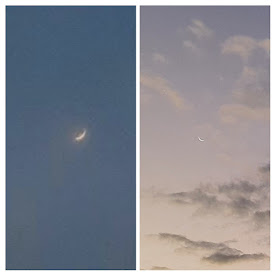Moon Upside-down
There's a plethora of articles elucidating how the moon and the constellations appear upside-down in Southern hemisphere. This fact piqued my interest. I requested a friend from Kolkata, India, in Northern hemisphere to share a picture of their moon on the same evening as I captured the silver sickle in Sydney’s sky in Australia. Here's the iconic collage of the moon viewed from both the hemispheres on 11th August 2021. The juxtaposition is a mirror image that reminds us of yet another astronomical phenomenon we take for granted.
Waxing crescent on western horizon: 🌒 in Northern and 🌘 in Southern hemisphere
But that's not all the surprise she has in store for us. How she manages to keep her far side, the darker side, away from us is another sleight of her hands. Known as tidal locking or synchronous rotation, this mechanism can be understood easily by doing a simple hands on exercise. Watch my video below on full screen, replay if you're not convinced with one round - this ten-second is the essence of twenty nine days that moon takes to circle us.
(Voice over video by my son Jish)
Here are the pictures that show the rotation clearly. It is recommended to click the images for a clearer view to observe the changing position of the text 'Convergys'.
It's obvious that moon, earth, and sun align on the same line twice a month, isn't it? Yet, we don't get solar and lunar eclipses so often. 🤷 Why? For a simple reason, I reckon! The orbital plane of moon is tilted at 5.15° with respect to earth's orbital plane!
This video has successfully simulated this inclination. It shows the first quarter is on the higher side, followed by fourth, third, and second as the earth revolves.
Apart from these two interesting facts, there's another one known as earth shine, which is apparently on decline in the recent past due to reduction in cloud cover. This is that curve of a gibbous or crescent moon that's adumbrated by sunlight reflected by earth and that completes the curve of the circle opposite to the curve that shines.
Well well, if you thought this is all, you are in for more surprises. Moon is beguiling - appearing here today, there tomorrow, and nowhere at times. Even if she does, her shape is different every day/ night. And then again she does not rise or set at the same point unlike our sun. To further add to the complexity, she is sometimes conspicuous when she is rising in the eastern horizon, sometimes when she is setting in the west, and yet at other times throughout the journey from east to west in the night sky.
After I captured and compared the waxing crescents of two hemispheres on western horizon I started contemplating about waning crescents. In my endeavour to photograph that, I ended up questioning myself, where is the moon gone? I simply couldn't find her in the western horizon at twilight for several evenings after I spotted her there first. That's when I started digging up and finally figured her whereabouts through a typical month. Looking forward to writing up that story on the discovery of waning crescent - 🌘 in Northern and 🌒 in Southern hemisphere. You'll know exactly when and which part of the sky to scan to find our dear moon.








Comments
Post a Comment
Many thanks!!!